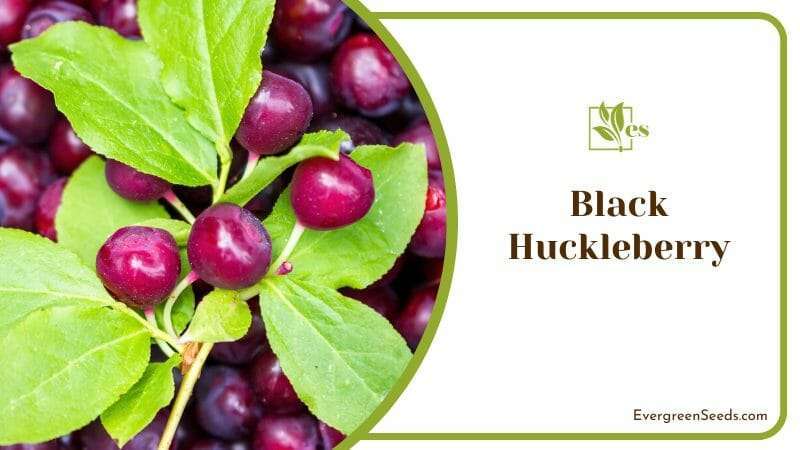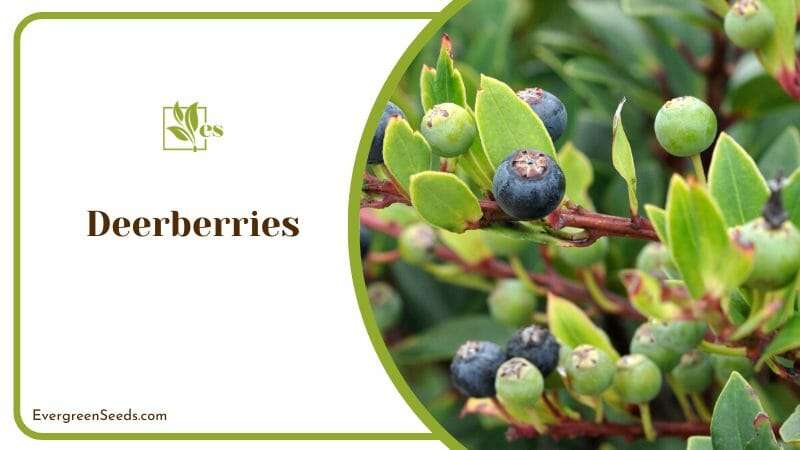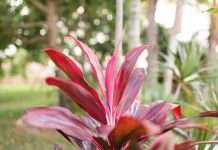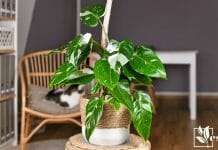Plants that look like elderberry can be found in the wild, or you can grow them in your garden. Foraging for edible berries is something that lots of adults and kids love to do, but unfortunately, some elderberry lookalikes might not be safe to touch.

However, others can be perfectly safe to eat. This article will tell you about 13 elderberry look-alike plants and what you need to know about them.
JUMP TO TOPIC
List of Plants That Look Like Elderberry
1. Black Huckleberry
Black huckleberries look very close to common elderberry and blueberry fruits. They grow from shrubs with toothed leaves and bear pink and yellow flowers in the summer. The berries are safe to eat, and most songbirds love them too. However, some people prefer to use them to make preserves and jams because they can be too acidic.

– What You Need To Know
The foliage of the black huckleberry bush turns reddish-purple in the fall, adding more life to your garden. The shrubs thrive in acidic soil, so you might find them along the edges of acidic forests and wooded areas.
In your garden, you need to start these shrubs in a pot and then transplant them after a couple of years. Once established, they become pretty easy to take care of.
2. Blueberry
Blueberry bushes bear the closest resemblance to black elderberry or Sambucus canadensis. The bushes are pretty easy to grow and have a moderate growth rate, and you can start them in pots or plant them directly in the ground. Do not confuse them with these plants that look exactly like blueberries.
The shrubs have leathery leaves that turn red in fall and produce clusters of white, bell-shaped flowers. These flowers turn into edible, delicious berries packed with healthy nutrients. Wild berries are smaller, so they’re easily mistaken for elderberries, but they’re sweeter than the ones grown in the garden.

– Issues
It takes a single blueberry shrub at least three seasons to bear a decent number of berries, yet this will improve for the next six seasons. Also, blueberries require acidic soil so you need to take care of that upfront.
An older shrub will suffer from a bigger transplant shock if you grow it in your garden, and it will take a lot of time to adjust. You should plant your blueberry shrubs away from taller trees that might shade them and protect them from the strong winds.
3. Jostaberry
The jostaberry is a cross between currant and gooseberry, and the shrub produces clusters of berries that change colors as the season progresses. Jostaberry shrubs have veiny leaves with teeth along the edges. The plant is cold hardy and thrives in well-draining soil with full sun access.

– Special Features
When the jostaberries appear, they’re green, then change to red and become violet-black when they mature, just like elderberries. This is how most people mistake them for one another.
However, unlike elderberries, jostaberries aren’t toxic when consumed raw, although they can be too acidic. They also grow red and purple flowers that you can easily set apart from the white elderberry flowers. Jostaberry shrubs take about three years to bear fruits, but will grow fruits for up to 15 years in the right conditions.
4. Gooseberry
Gooseberries can be found in the wild, and they grow on thorny shrubs. The shrubs can be four feet tall, growing greenish-white flowers that look nothing like the ones you see on an elderberry plants. However, some cultivars also grow pink and yellow flowers. The fruits ripen in mid-summer and taste sour, so most people use them to make preserves and jams.

– Growing Conditions
Growing your own gooseberry bush is possible as this plant is pretty easy to take care of. However, the thorns on the bushes can make harvesting pretty challenging, so you need to wear protective gloves before touching this plant.
In warmer climates, gooseberry bushes need protection from the strong afternoon sun, but they can tolerate full sun in colder climates. The plant is tolerant of many soil conditions, and once established, you’ll have to water it only in the absence of weekly rainfall.
5. Bilberry
Bilberries or British blueberries are edible berries that usually grow in the wild. Bilberry is a highly prized berry that is not typically easy to find because it grows on high grounds and in hard-to-reach places.
The bush thrives in acidic, well-draining soil that needs to be kept moist. It tolerates partial shade but thrives in full sun. When the soil is too alkaline, you might want to grow your bilberries in a pot.

– How To Identify
Mature berries can make elderberry identification quite challenging, as the berries look very similar when they ripen. However, to set them apart, you can look at the red or pink bell-shaped flowers that grow on the bilberry shrub.
The shrubs also look wiry, and the berries taste too acidic. Yet, they complement the taste of many sweet and savory dishes. You might encounter these not-so-easy-to-find berries in the supermarket during the months of August and September.
6. Blackcurrant
Blackcurrant bushes can be grown in your garden or in containers, growing clusters of white-greenish elderberry flowers look-alikes. However, some varieties also grow yellow or reddish flowers. You can usually find two-year-old bare-root plants for sale, which can easily be grown in your garden.
The shrubs are cold hardy, but the low temperatures can decrease the quality of the harvested berries.

Blackcurrants are rich in vitamin C and can be eaten raw or served in many sweet and savory dishes. They have an intense, tart, grape-like flavor and are used to make syrups, juices, and ink.
– Care Tips
Blackcurrant bushes are tolerant of many light and soil conditions where an elderberry bush won’t grow, but they thrive in well-draining, moist soil with adequate access to full sun. They don’t perform well in containers, but they can bear berries for a few years, although in this case, they’ll be mostly grown as ornamental plants.
7. Black Chokeberry
The black chokeberry plant is an attractive shrub that grows upright and rounded. It’s an excellent choice for your landscape, providing year-round interest. In spring and early summer, the shrub grows beautiful white flowers with pink centers that turn into edible black-purple berries by the end of the summer.

In winter, the foliage turns into an outstanding purple-red color. Moreover, this shrub is quite easy to maintain as it can survive in many light, water, and soil conditions.
– What You Need To Know
The berries are named this way because they’re too bitter so they can choke you, but they aren’t toxic. This plant grows suckers that need to be kept under control and can be planted from softwood cuttings in the summer. However, growing black chokeberries from seed is pretty challenging.
8. Deerberries
Highbush huckleberry or deerberry shrubs can grow to reach a height between 12 and 15 feet. They have short leaves that are not glossy, and the bark is reddish brown. In the summer, the deerberry bush will grow attractive white bell-shaped flowers that turn into deep purple-black berries by the beginning of fall.
You can grow this bush next to your elderberry plants because it thrives in acidic soil.

It can survive in partial shade, so you might want to grow it next to an elderberry tree.
– Special Features
As the name suggests, deer are very fond of deerberries, and they also appeal to different birds and animals. However, humans find them too bitter and sour, so they must be sweetened first before consumption.
9. Blackthorn Berries
The blackthorn shrub or tree is usually grown as a border plant. In optimal conditions, this shrub grows to be 16 feet tall, with black bark and spiny branches that usually tangle.
In spring, this bush grows beautiful white flowers that turn into waxy black-purple berries.

The berries ripen and are ready to harvest by fall. These berries are usually used to make preserves and alcoholic drinks.
– Issues
The branches of the blackthorn bush are covered in thorns, so you should handle them carefully. However, they’re pretty sturdy and are often used to make walking sticks, especially in Ireland. When they’re raw, the blackthorn berries are quite bitter, sour, and tart, but they become a little sweeter as they mature. However, the pits contain traces of hydrogen cyanide.
10. Pokeweed
If you plan to harvest elder fruits and encounter an upright bush with dangling elderberry-like fruits, you’ve probably found pokeweed.
Phytolacca americana, or pokeweed, is an invasive weed that grows in the wild and can be found in your garden if it’s not well-maintained. Pokeberries are extremely toxic to humans and pets, although people use them for coloring in several industries.

– How To Identify
Identifying pokeberries is crucial as you can easily find pokeweed where your elderberries grow. The stems of the weed are reddish-purple, and the leaves are egg-shaped, producing a foul smell when crushed. The weed stands at 10 feet tall in optimal growing conditions, growing unremarkable whitish-green flowers.
It might look like this plant dies in winter, but the taproot stays alive, so you must remove it with a shovel. However, if you want to grow pokeweed for ornamental purposes, you can grow it in a pot on your deck or patio, where it can be kept under control and away from pets and children.
11. Water Hemlock
Water hemlock can be mistaken for Sambucus nigra because it grows similar-looking flowers and berries. But the easiest way to identify these two plants is to take a look at the area. If the bush or tree seems to grow in a dry area, then it’s probably an elderberry plant since water hemlock grows in wet environments.

Identifying water hemlock berries is crucial because these elderberry look-alikes are incredibly toxic and can lead to seizures or even become fatal when consumed in moderate amounts.
– Description
Water hemlock flowers grow in spring and early summer, resembling the look of the flowers you can see on elderberry trees, except that they’re smaller. The stems are herbaceous, so you won’t see any bark on them, unlike elderberry bushes. The water hemlock plant can grow submerged in water and can survive in many soil and light conditions.
12. Devil’s Walking Stick
Aralia spinosa, or the devil’s walking stick shrub, is one that you can easily mistake for an elder tree or bush because it looks similar.
As a matter of fact, some people call it prickly elder, referring to the sharp spines that grow along the stems. The devil’s walking stick can reach a height of 20 feet, and despite the mild toxicity of the fruit, many people choose to grow it as an ornamental plant.

– What You Need To Know
The devil’s walking stick grows lemon-scented umbrella-like clusters of whitish-green flowers that Native American women usually put in their hair for their gorgeous smell. They bloom in summer and then turn into purple-black fruits.
This berry was mainly used to treat toothache and induce vomiting, but it appeals to bears as well. The devil’s walking stick thrives in partial shade and can handle different soil conditions as long as it’s moist and well-draining.
13. Deadly Nightshade
Belladonna or deadly nightshade shrubs grow dark purple-black berries that someone might mistake for elderberries. However, these berries are highly toxic and can quickly kill humans, so identifying this plant in the wild or your garden is essential.
All parts of the belladonna plant or deadly nightshade plant are toxic to humans and pets, although they’re not toxic to birds and wildlife. However, if bees consume the belladonna nectar, their honey will be toxic to humans.

– How To Identify
Belladonna, or deadly nightshade plants, have vine-like branches and grow greenish-purple or lavender bell-shaped flowers in the spring. The berries are green when they emerge, and they darken to reach their mature shiny black color.
The leaves aren’t evenly sized, and they’re solitary on the outer parts of the plant. If you find this imposter in your garden, dig out all parts of the roots and dispose of them. Then you should disinfect all your tools before you can use them again.
Final note:
Pokeweed, water hemlock, the devil’s walking stick, and the deadly nightshade are poisonous plants that you should avoid.












